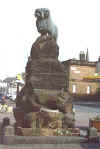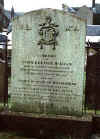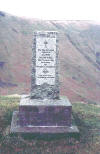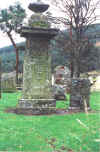|
Moffat
and the Devil`s Beef Tub

An early
stopping place on my journeys to Scotland is the near
border town of Moffat, where a welcome break and a
cup of tea with a home baked scone can be taken in the
cafeteria of the woollen shop. Moffat was for a long time
an important junction on the early roadways with routes
from there to Selkirk to the north east, Edinburgh to the
north and Glasgow to the north west. Located in a district
famed for it wool and its sheep, the visitor is reminded
by the statue of the` Moffat Ram` – locally called
the `Great Sheep`, that dominates the town centre.
 A A
stroll down to the old church yard which lies just off the
main street, will introduce you to the `table` gravestones
which are quite common in Scotland. Some of the original
church wall still stands and several notable gravestones
are to be found, including that of James McGeorge ,
 a a
railway guard who died in a severe snowstorm in 1831
trying to get the mail through. Close by is the burial
place of John Loudon MacAdam (1756-1836) the Scottish
engineer who invented the road surfacing used worldwide.
Born in Ayr, he was the son of James McAdam one of the
founders of the first bank in that town, and attended
school in Maybole. The family originated from Waterhead in
Kirkcudbright where they had a presence in the mid
seventeenth century. When his father died in 1770 he was
sent to America under the care of an uncle, a merchant in
New York. While there, throughout the War of Independence,
he married the daughter of William Nicoll. He
returned to Scotland in 1783 and bought an estate at
Sauchie near Ayr where he began his experiments in road
making. He became Deputy Lieutenant of the county and then
took on the job of organising stores for the navy in
Bristol. It was here that in 1815 he became the surveyor
to the Turnpike Trust and began to put his theories into
practice with great success. Like so many inventors, he
was almost destitute in later years having expended a
substantial fortune on his work. Belatedly the government
voted him £10,000 but he only ever received £2000;
and he subsequently declined the offer of a knighthood.
From Moffat
we took the A 701 and headed for Biggar where there is a
Covenanter Museum, this is a fully restored seventeenth
century
 farmhouse farmhouse
that has been moved to its present site. An earlier
reminder of the Covenanters comes, however, with the
monument alongside the road to John Hunter of Tweedsmuir,
a farmer who was shot by troopers in 1685 when trying to
outrun them up the steep bank of the `The Devil`s Beef Tub
`. The `Beef Tub` is so called because it is a blind
valley with very steep sides at its end, in which stolen
or `houghed` cattle were
hidden away by the Border Reivers. At the bottom of the
deep valley can be seen a stone enclosure which is
probably a relatively modern sheep pen but the imagination
can easily see a corral where the stolen cattle were
held. It is recorded that Hunter was in the locality
visiting a sick friend at nearby Corehead and he and
another man, Welsh of Tweedlehopefoot, (also called
the `Babe of Tweedlehopefoot` from his gentle nature) had
made a dash for it when troopers came to the house. Welsh
later found sanctuary at a farmhouse where he fell asleep
in front of the fire. The troopers soon arrived at that
farm but the quick thinking housewife slapped Welsh and
berated him for lazing in front the fire and drove him out
the house, fooling the troopers and saving Welsh`s life.
On the way
keep an eye open to your right for the origins of the
River Tweed, – the area known as Tweeds Well, where spring
water rises to
 the the
surface and begins its 100 mile journey to the sea.
There is a small lay by and monument on the left hand side
of the road. A few miles further on it is only a small
diversion off the main road to turn into the quiet village
of Tweedsmuir and visit the local church where John Hunter
lies buried. A picturesque churchyard with many table
stones, the grave of the martyr is in the lower yard. Next
the door to the church is a tall 19th century monument to
him which records the savage manner of his death.

IN MEMORY OF
JOHN HUNTER
MARTYR
WHOSE
GRAVESTONE
IS IN THE LOWER PART
OF THIS
CHURCHYARD
1837.
JOHN HUNTER
a Tweedsmuir lad was
accidentally visiting a sick friend at Corehead when
timely in the morning he was surprised with Douglas
and his dragoons. He fled to the hill a great way,
but one named Scott, being well horsed compassed him
and came before him He was most barbarouslie shot
through the body, felled on the head with the neck
of a gun, and casted headlong over a high steep
craig
Biggar Covenanter Museum
|